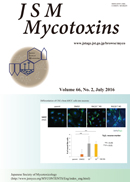
- Issue 2 Pages 111-
- Issue 1 Pages 1-
- |<
- <
- 1
- >
- >|
-
Yosuke Matsuo, Kentaro Takahara, Hidemi Hatabayashi, Masayo Kushiro, H ...2016Volume 66Issue 2 Pages 111-118
Published: July 31, 2016
Released on J-STAGE: September 06, 2016
JOURNAL FREE ACCESSDetection of fumonisin C1, C2 and C3 (FCs) in a reference material of corn powder was performed with LC-Orbitrap MS. The peaks of FCs were eluted 0.1 ~ 0.3 min earlier than those of fumonisin B1, B2 and B3 (FBs), from the C18 column, probably due to the lacking of terminal C-1 methyl group of FB molecule structures. At negative ionization mode scan with LC-MS analysis, the fragment ions of the tricarballylic acid (TCA) and characteristic fumonisin ions lacking TCA were detected at the identical retention times with those of respective parent FCs. Mass fragmentation patterns of FCs were confirmed to be almost in consistent with those of FBs. This study is the first report of natural co-occurrence of FC1, FC2, and FC3 in corn powder.
View full abstractDownload PDF (1079K)
-
Fumio Tashiro2016Volume 66Issue 2 Pages 119-123
Published: July 31, 2016
Released on J-STAGE: September 06, 2016
JOURNAL FREE ACCESSThe acquisition of stemness, which epigenetically induced and maintained by Yamanaka factors, Oct4, Sox2, Klf4, and c-Myc, is a hallmark of malignant hepatocellular carcinoma (HCC). We found that deregulated expression of Sry (sex-determing region Y) is involved in the acquisition of tumor malignancy of aflatoxin B1 (AFB1)-induced male rodent (r) HCC K2 cells, in which 89% of the population is cancer stem cells (CSCs) due to the robust potentiation of Sry/SGF29/c-Myc pathway. In human (h) HCCs, overexpressed Sry activates directly the CSC marker Oct4 expression, while its knockdown decreases Oct4 expression and CSC natures including self-renewal, tumorigenicity and chemoresistance. Thus, these facts indicate that Sry takes part in the induction and maintenance of CSCs in HCCs. Moreover, CSCs from hHCCs could differentiate into Tuj1-positive and Ki67-negative neurons having long neurites in the presence of retinoic acid (RA). Taken together with the fact that deregulated expression of Sry mRNA can be detected in three out of the eighteen male patients with HCC tested, differentiation-inducing therapy targeting HCCs-derived CSCs, which play a central role in tumor redevelopment, is fully promised for rooting out of cancer.
View full abstractDownload PDF (673K)
-
Hirokazu Tsubone, Masakazu Hanafusa2016Volume 66Issue 2 Pages 129-143
Published: July 31, 2016
Released on J-STAGE: September 06, 2016
JOURNAL FREE ACCESSToxic effects of trichothecene mycotoxins, mainly of T-2 toxin and deoxynivalenol (DON), were reviewed in the present study. These toxins exhibit a wide range of toxicity as acute and chronic effects on morphology and function in living bodies or cells. Most studies have reported the concentration- or dose-dependent disorders in cells and/or organs exposed to T-2 toxin or DON. In a number of studies the apoptotic changes in various organs or cell lines were recognized in vivo or in vitro studies, and the oxidative stress has been noticed as an important factor to cause the apoptosis. The most feasible pathways such as a ribosome-MAPK (JNK/p38), primary DNA damage, and death receptor/caspase-8 pathway has been proposed as triggering mechanisms to elicit the apoptotic alterations due to these mycotoxins.
View full abstractDownload PDF (1196K)
-
Hiroyuki Nakagawa2016Volume 66Issue 2 Pages 149-153
Published: July 31, 2016
Released on J-STAGE: September 06, 2016
JOURNAL FREE ACCESSAn international symposium on mycotoxin entitled “WMF 2014” (the 8th Conference of the World Mycotoxin Forum) was held in Vienna (Austria) in November 2014. Many people from all over the world participated to this symposium, and lectures of more than 70 speakers and posters of more than 160 researchers were presented throughout the conference, resulting in active and fruitful discussions among the participants. This report shows a summary of the symposium with introductions of several topics provided there.
View full abstractDownload PDF (1454K)
- |<
- <
- 1
- >
- >|